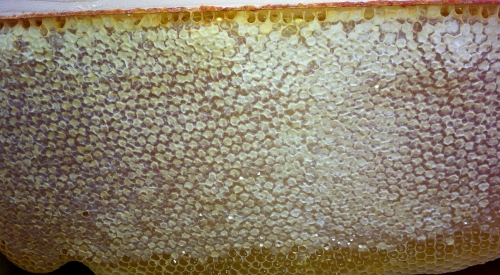
Late Summer/Fall Inspections
There are 3 dangers to your hive that can prevent successful overwintering.
1. No mated queen in September. No laying queen, no bees produced to go through winter.
2. Too little honey for Winter. Fewer than 10 frames of honey in the brood boxes is bad news.
This can happen when the bees are storing honey in the honey supers in September, ABOVE the brood nest,
and "think" the box above the queen excluder will be coming through winter with them.
3. A high mite load in September. This can be due to home-grown mites, or imported mites from a nearby hive dying in fall.
Avoiding hive loss in Winter due to lack of a laying queen in September.
There must be eggs and larvae in the hive in early Sept and mid Sept. Capped brood can be misleading - it will be present even if
the queen WAS there 2 weeks ago, but swarmed recently.
No eggs and larvae in Sept? I would combine this hive with another, but I have more than one hive. Sometimes more than 31, in fact.
If this is your only hive, your best bet is to get a buddy who can give you a frame of eggs. You can get away with saving the hive
if you find out in early Sept that the hive has no queen - in OH, there is just barely enough time to get enough winter bees made
to make it through winter. See my queen cells page for more about the strategy to use.
Presence of younger larvae at the bottom of the frame in Sept - all good.

Avoiding hive loss due to low stores.
Check in mid Sept that the top frames are filling with honey, and don't have capped brood. The bees will store the nectar in the brood cells in the top box, and force the queen down. We don't want to see the top box full of honey in August; that means if there is a fall flow after August, the bees will get a signal "Incoming Nectar! No Storage! Time to Swarm..." and we don't want that. You will want to give the bees somewhere to work during a flow, or somewhere to fill comb with nectar. Tricky balance. Welcome to the joys of beekeeping.

Avoiding hive loss due to Varroa Mites - Top Killer of Hives
- There are two ways varroa mites kill hives:
- by increasing in number through the summer, until they are at a crushing amount (think 5000 mites) by fall, at which point they are only on adult bees, which is deadly;
- or by immigrating into a hive during the fall, like 2000-4000 over the course of a month or so. This is also deadly.
I've seen them both. By treating with Apivar when you first got your bees, you have dodged the first
danger from mites. You can find out if mites are immigrating by doing potentially unnecessary
mite treatments in the fall, or by finding a dead (or live) hive in spring - it's a gamble.
I prefer to treat for mites during our mite immigration period, which is Oct through Nov, whether the
bees need it or not.
I use Oxalic acid vaporization, but you could use both Apivar in early Oct,
then Oxalic Acid Dribble towards the end of Nov. That timing is critical to catch all
the mites which might be immigrating into the hive during fall.